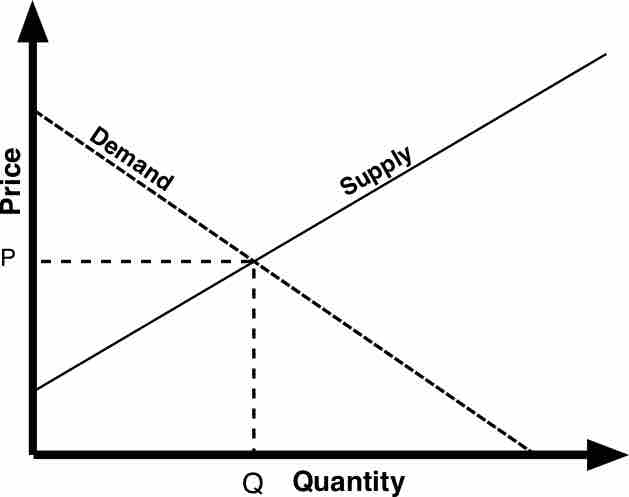What is a Market?
In mainstream economics, the concept of a market is any structure that allows buyers and sellers to exchange any type of goods, services, and information. The exchange of goods or services for money is called a transaction. Market participants consist of all the buyers and sellers of a certain good, thus influencing its price.
This influence is a major study of economics and has given rise to several theories and models concerning the basic market forces of supply and demand . There are two roles in markets, that of a buyer and that of a seller. The market facilitates trade and enables the distribution and allocation of resources in a society.

Supply and Demand
This graph depicts where a supply, such as a business, intersects with demand, such as the market need.
Markets allow any tradeable item to be evaluated and priced. It emerges more or less spontaneously or is constructed deliberately by human interaction in order to enable the exchange of services and goods. Historically, markets originated in physical marketplaces which would often develop into—or from— small communities, towns and cities.
A firm in the market economy survives by producing goods that persons are willing and able to buy. Consequently, ascertaining market needs is vital for a firm's future viability, and even existence, as a going concern.
Many companies today have a customer focus (or market orientation). This implies that the company focuses its activities and products on consumer demands. In the consumer-driven approach, consumer wants are the drivers of all strategic marketing decisions. No strategy is pursued until it passes the test of consumer research.
Every aspect of a market offering, including the nature of the product itself, is driven by the needs of potential consumers. The starting point is always the consumer.
Market Research
Market research is a key factor in obtaining an advantage over competitors and is necessary in order to determine market needs that can and should be met.
It is the systematic gathering and interpretation of information about individuals or organizations through the use of statistical and analytic methods in order to gain insight or support decision making, and includes both social and opinion research. Market research provides important information that identifies and analyzes the market's need, size, and competition; thus making it possible to determine how to market a product.
Market segmentation is the division of the market or population into subgroups with similar motivations. It is widely used for segmenting the various differences within the market: geographic, personality, demographic, technographic, use of product, psychographic, and gender. This allows firms to further distinguish market needs by subdividing and focusing on various groups within markets.
Market Trends
Market trends are the upward or downward movement of a market during a period of time. Analyzing these trends is another method that allows firms to decipher the needs of markets and strive to meet them.
The market size is more difficult to estimate if one is starting with something completely new. In this case, one would have to derive the figures from the number of potential customers, or customer segments. Besides information about the target market, one also needs information about one's competitors, customers, and products. Lastly, one needs to measure marketing effectiveness.
As an example of a process of addressing market needs, imagine the release of a new film. When performing marketing research on it, here are several practices that a studio may use:
- Concept testing, which evaluates reactions to a film idea and is fairly rare,
- Positioning studios, which analyze a script for marketing opportunities,
- Focus groups, which probe viewers' opinions about a film in small groups prior to release,
- Test screenings, which involve the previewing of films prior to theatrical release,
- Tracking studies, which gauge (often by telephone polling) an audience's awareness of a film on a weekly basis prior to and during theatrical release,
- Advertising testing, which measures responses to marketing materials such as trailers and television advertisements,
- Exit surveys, which measure audience reactions after seeing the film in the cinema.